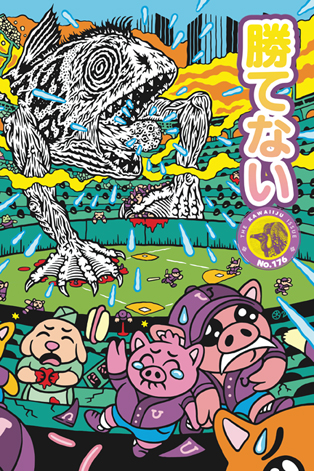
Godzilla’s Legacy of Humans

This column is a reprint from Unwinnable Monthly #176. If you like what you see, grab the magazine for less than ten dollars, or subscribe and get all future magazines for half price.
———
Here’s the Thing is where Rob dumps his random thoughts and strong opinions on all manner of nerdy subjects – from videogames and movies to board games and toys.
———
There were so, so many complaints about the lack of radioactive lizard screen time in Godzilla (2014) and I get it. People were expecting to spend more time with the title character – and more time with Bryan Cranston – so the drip-feeding of Big G might have been a bit frustrating. Factor in all the time the movie spends with its human cast and the complaints almost make sense. Almost. But here’s the thing: Humans have always been a necessary part (sometimes even focus) of Godzilla stories because, despite being the titular character, it was never about Godzilla.
The entire point of Godzilla (both the monster and the core premise) is to paint the consequences of human war, greed and indifference to nature in a new light. In 1954 he was a stand-in for American atrocities committed with nuclear bombs. In 1984 he was still a walking warning about nuclear war but was tied more closely to Cold War concerns. Throughout the Heisei era he was a force of nature – a tsunami or earthquake on two legs – often depicted as a more antagonistic force. In 2016, the themes shifted to the ways government bureaucracy can ultimately lead to more harm than good, with a healthy dose of improperly regulated (or at least enforced) environmental protections. And at the heart of all of these stories are humans who are either impacted by the devastation, desperately trying to do what they can to protect other people from it, occasionally making things worse, or sometimes all of the above.
What Monarch: Legacy of Monsters does is run with this idea – the real idea – of Godzilla and tell a very human story with kaiju (or in this case, titans) being treated more like the unpredictable natural disasters they’ve always been and were always supposed to be. It’s not a show about Godzilla or any of the other giant monsters, it’s a show about some very flawed characters dealing with loss, hope, disappointment, success and generally just doing the best they can in the unprecedented situations they find themselves in. Some of this is likely due to budgetary reasons (animating titan set pieces has got to be expensive), but it works well in Monarch because of the pacing, writing and acting.

I’m also going to argue that a movie or show that’s just non-stop monster fights would get really boring really fast. Of course, it’s cool to see these massive monsters brawl with each other, but can you honestly say that a 30-45 minute episode – or worse, a 90 to 120 minute long movie – would be better if the only plot elements were watching which kaiju did which move? Really? If so, what you want isn’t a TV show or movie, you just want to watch a boxing match between people in rubber suits – which we already have. Peaks and valleys in the action are essential to making a story more interesting because it gives the audience time to breathe between vicarious adrenaline rushes and it gives the more frantic moments much more impact. By telling interesting stories with its human cast, Monarch gives those intense monster moments so much more weight than they would’ve had otherwise.
Obviously, I’m going to point to this show as an example of a Godzilla story with lots of human moments “done right,” but in all honesty it would still be a solid branch of the series even if the humans were handled poorly. Because extremely well-acted or not, well written or no, Godzilla is and always will be at its best when tells a serious story that puts people over monsters.
———
Rob Rich is a guy who’s loved nerdy stuff since the 80s, from videogames to anime to Godzilla to Power Rangers toys to Transformers, and has had the good fortune of being able to write about them all. He’s also editor for the Games section of Exploits! You can still find him on Twitter, Instagram and Mastodon.




